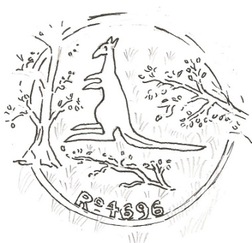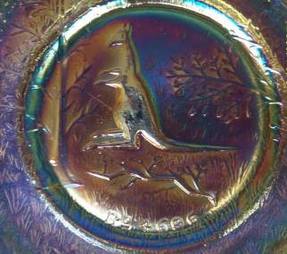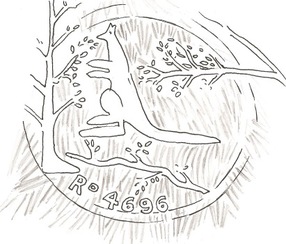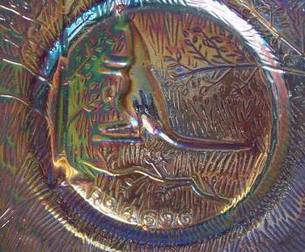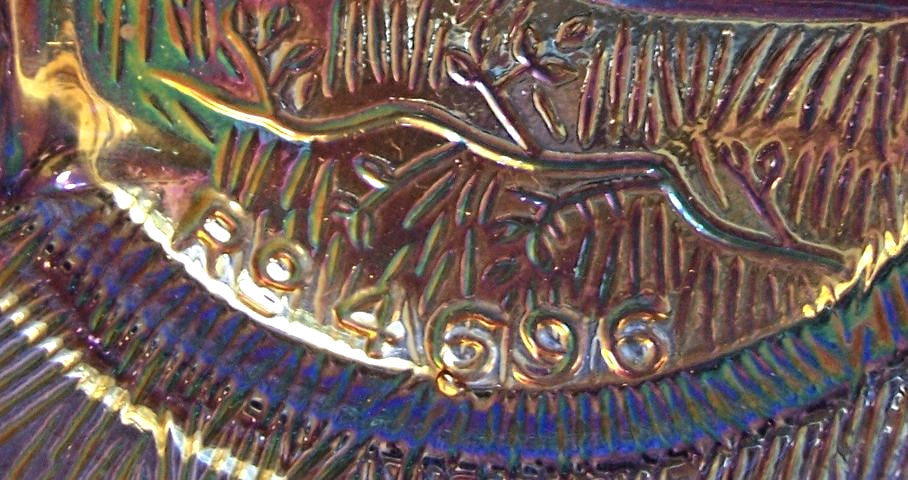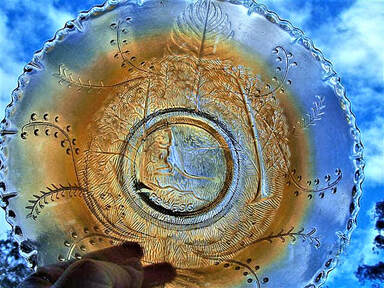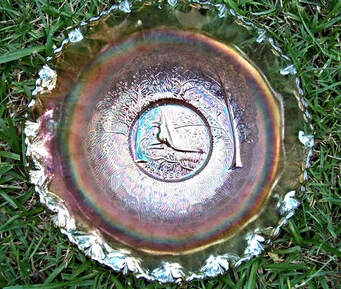Collectors Facts - Kangaroo Fakes
|
Shapes:
Master berry bowl
|
Colours:
Marigold; Amber; Pink; Light blue/crystal; pearly white
|
There are two known versions of the original Crown Crystal Kangaroo pattern - one version has a larger Kangaroo and no branch below it, the other version (known as the "Small Roo" or "Doe") has a branch below the kangaroo.
Then, first reported by Julie Hynes in November 2006, a large master Kangaroo bowl turned up - it was clearly not like the original Crown Crystal item.
By late spring, 2007, more of these large master Kangaroo bowl had appeared - they are the "Small Roo" / "Doe" version with a branch below the kangaroo. Like the original Crown Crystal bowls, these imitations also have the registered design number 4696 moulded into the pattern. The bowl also has what appears to be a Fern & Wattle exterior pattern. Examples have been seen in marigold, amber and pink as well as light blue, crystal and a pearly white, with pastel iridescence.
Comparative study of the original and recently seen Kangaroo patterns, however, shows very clearly that this new bowl is not like the original design, as there are many differences. Shown above are close up photos (courtesy Julie Hynes) and comparative sketches of the kangaroo on both an original and a new imitation bowl, showing the fundamental differences between the versions.
Then, first reported by Julie Hynes in November 2006, a large master Kangaroo bowl turned up - it was clearly not like the original Crown Crystal item.
By late spring, 2007, more of these large master Kangaroo bowl had appeared - they are the "Small Roo" / "Doe" version with a branch below the kangaroo. Like the original Crown Crystal bowls, these imitations also have the registered design number 4696 moulded into the pattern. The bowl also has what appears to be a Fern & Wattle exterior pattern. Examples have been seen in marigold, amber and pink as well as light blue, crystal and a pearly white, with pastel iridescence.
Comparative study of the original and recently seen Kangaroo patterns, however, shows very clearly that this new bowl is not like the original design, as there are many differences. Shown above are close up photos (courtesy Julie Hynes) and comparative sketches of the kangaroo on both an original and a new imitation bowl, showing the fundamental differences between the versions.
|
The first thing that strikes most people when they study the imitation bowl is the long stripey grass. It is so noticeable - long, bold gashes - nothing at all like the gentle clumps that appear on the genuine originals. And it is everywhere! Even appearing to stick out of the tops of the trees - there's nothing remotely artistic or subtle about it. It's almost as if the mould cutter couldn't be bothered to think what he was doing and just threw in lots of stripes, anywhere and everywhere. The grass on the new imitation bowl even appears to be growing up over the trees! The entire bowl is covered with the stuff.
Another very clear difference is one that can also be noted and recognised easily. On the original item, there is a quite a big gap between the R of the RD number, and the base of the tree. On the imitation however, the letter R almost touches the tree base. This is a very clear characteristic of this new bowl. Also on the imitation new bowl, the letters are clearly RO (instead of RD, as in Registered Design). This can be seen on Julie Hynes excellent close-up photo, shown on the right. It is interesting to note that a characteristic of one of the versions of the fake Kingfisher nappy bowls is the use of the letters RP instead of the correct version, RD. |
The fake "RO" (instead of "RD") registered number. Courtesy of Julie Hynes
|
It is possible that this mix-up of the letters was due to the mould-maker’s lack of familiarity with the letters of the Roman/English alphabet.
There are many other differences in proportion too. Look how close the leaves are to the kangaroo's face on the new version on the left. Now look how much further away they are on the original (in fact on some old bowls the leaves to the left of the kangaroo's face are very indistinct and hard to see). There are similar differences at the back of the kangaroo too. Look how close the branch is on the new bowl - and notice that it is further away on the original.
Another clear difference is the base of the tree seen at the left of the kangaroo. On the original, the roots at the base of the tree go off to the left, over the circle of the base (marie). But on the new one, the base of the tree goes straight down on its left hand side, and does not go over the circle of the marie.
There are many more small pattern differences:-
- a strange "swelling" where the kangaroo's knee/thigh should be
- the neck of the animal is thick and oddly shaped and the head is differently shaped
- front paws are mis-shapen
- the branch on the right is angled the wrong way.
- the branch below the kangaroo is different
- the entire pattern is skewed somewhat on the right hand side of the "fake".
An interesting observation was posted on the internet courtesy of Margaret and John McGrath (experienced Australian Carnival collectors) back in 2007. It was reported that the imitation Kangaroos arrived on the market early in 2007. The following is a quote: they were “available in the following colors (described by the importer) … icy blue, pink, amber, brown/marigold, green and white Carnival Glass”. (Note that these colours are similar to those reported for the fake Kingfisher nappy bowls, especially the pearly white iridescent*). Further observations included the fact that they had been seen on dealers stalls at antique and collectable fairs, and the examples with the “RO” number had higher prices than those without the number.
The date they appeared - 2006/2007 - is the same time that the new Koala bowls appeared. Interestingly, these new Koala bowls (made in China and marked "summerland.1"), and the fake Kangaroo bowls have the same back pattern of Australian flora, fern and wattle - which copies the same design that is found on some Classic Crown Crystal 9 inch bowls.
It is possible that this mix-up of the letters was due to the mould-maker’s lack of familiarity with the letters of the Roman/English alphabet.
There are many other differences in proportion too. Look how close the leaves are to the kangaroo's face on the new version on the left. Now look how much further away they are on the original (in fact on some old bowls the leaves to the left of the kangaroo's face are very indistinct and hard to see). There are similar differences at the back of the kangaroo too. Look how close the branch is on the new bowl - and notice that it is further away on the original.
Another clear difference is the base of the tree seen at the left of the kangaroo. On the original, the roots at the base of the tree go off to the left, over the circle of the base (marie). But on the new one, the base of the tree goes straight down on its left hand side, and does not go over the circle of the marie.
There are many more small pattern differences:-
- a strange "swelling" where the kangaroo's knee/thigh should be
- the neck of the animal is thick and oddly shaped and the head is differently shaped
- front paws are mis-shapen
- the branch on the right is angled the wrong way.
- the branch below the kangaroo is different
- the entire pattern is skewed somewhat on the right hand side of the "fake".
An interesting observation was posted on the internet courtesy of Margaret and John McGrath (experienced Australian Carnival collectors) back in 2007. It was reported that the imitation Kangaroos arrived on the market early in 2007. The following is a quote: they were “available in the following colors (described by the importer) … icy blue, pink, amber, brown/marigold, green and white Carnival Glass”. (Note that these colours are similar to those reported for the fake Kingfisher nappy bowls, especially the pearly white iridescent*). Further observations included the fact that they had been seen on dealers stalls at antique and collectable fairs, and the examples with the “RO” number had higher prices than those without the number.
The date they appeared - 2006/2007 - is the same time that the new Koala bowls appeared. Interestingly, these new Koala bowls (made in China and marked "summerland.1"), and the fake Kangaroo bowls have the same back pattern of Australian flora, fern and wattle - which copies the same design that is found on some Classic Crown Crystal 9 inch bowls.
Above: left, the exterior floral design of the fake Kangaroo bowls, and right the front pattern. Pictures courtesy of Julie Hynes
* these colours, especially the pearly white colour, are very reminiscent of the fake Fenton pieces that are known about, namely "Stag and Holly" and "Butterfly and Berry".
